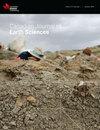Trans-Avalonian green–black boundary (early Middle Cambrian): transform fault-driven epeirogeny and onset of 26 m.y. of shallow marine anoxia in Avalonia (Rhode Island–Belgium) and Baltica
IF 1.6
4区 地球科学
Q3 GEOSCIENCES, MULTIDISCIPLINARY
引用次数: 3
Abstract
The Avalonia microcontinent has diagnostic terminal Ediacaran–Ordovician lithostratigraphy, depositional sequence architecture, and igneous activity that extends for 2000+ km and reflects epeirogeny related to the Avalonian transform fault. Avalonia records an abrupt early Middle Cambrian (late Wuliuan) change from green, purple, or light grey to overlying black, dark grey, and brown facies in platform and off-platform areas (Meguma, North Wales). This change within one trilobite zone marks onset of ca. 26 m.y. of shallow-marine anoxia/strong dysoxia lasting into the Ordovician with Hatch Hill OMZ onlap onto the shelf. A Bakken model (new, based on the middle Paleozoic Bakken Formation) is applied to shallow-shelf–shoreline organic-rich mud deposition. Erosion of greenish Avalonian depositional sequence (Ads) 7 was followed by Ads 8 tilting, volcanism, debris flows, and bentonite deposition on a cryptic unconformity in SE Newfoundland. The early Middle Cambrian age of the Ads 7–8 boundary is obscured by referring the lower Manuels River Formation and Cristallinium cambriense Zone to the younger Drumian Stage. Ads 8 has thin ashes in coterminous British and American Avalonia where erosion and subaerial exposure with caliche development preceded onlap of upper Middle or Upper Cambrian Ads 9 black muds and sands. The green–black change emphasizes Avalonian unity; it precludes multiple Avalonian “micro-terranes” or assigning parts of Avalonia to West Gondwana or “Ganderia” (the Little River, Brookville, and Bras d’Or “terranes” are part of the Avalonian marginal platform). Coeval green–black transitions and similar later Cambrian faunas show comparable paleoenvironments in Avalonia and Baltica.跨阿瓦洛尼亚绿黑边界(中寒武纪早期):阿瓦洛尼亚(罗德岛-比利时)和波罗的海地区转换断层驱动的造山运动和26年浅海缺氧的开始
阿瓦洛尼亚微大陆具有诊断性的埃迪卡拉—奥陶系晚期岩石地层、沉积层序构型和火成岩活动,延伸2000+ km,反映了与阿瓦洛尼亚转换断层有关的造陆作用。Avalonia记录了中寒武纪早期(五流晚期)台地和台地外地区从绿色、紫色或浅灰色到覆盖的黑色、深灰色和棕色相的突变(北威尔士Meguma)。在一个三叶虫带内的这种变化标志着大约26英里的浅海缺氧/强缺氧的开始,这种缺氧持续到奥陶纪,并与Hatch Hill OMZ重叠到大陆架上。将以中古生代巴肯组为研究对象的新巴肯模型应用于浅海架-岸线富有机质泥质沉积。在纽芬兰东南部,绿色Avalonian沉积层序(Ads) 7的侵蚀之后是Ads 8的倾斜、火山作用、碎屑流和膨润土沉积。通过将下曼努埃尔河组和水晶寒武纪带与更年轻的德鲁米安阶段相比较,可以模糊ad7 - 8的中寒武纪早期。广告8在邻近的英国和美国阿瓦洛尼亚有薄薄的灰烬,在那里,侵蚀和地面暴露与石灰发育先于中上寒武纪或上寒武纪黑色泥浆和沙子的覆盖。绿黑色的变化强调了阿瓦洛尼亚的统一;它排除了多个阿瓦洛尼亚“微地体”或将阿瓦洛尼亚的部分地区划分为西冈瓦纳或“Ganderia”(小河,布鲁克维尔和布拉斯达尔“地体”是阿瓦洛尼亚边缘台地的一部分)。在阿瓦洛尼亚和波罗的海,同时期的绿黑过渡和类似的寒武纪晚期动物群显示出相似的古环境。
本文章由计算机程序翻译,如有差异,请以英文原文为准。
求助全文
约1分钟内获得全文
求助全文
来源期刊

Canadian Journal of Earth Sciences
地学-地球科学综合
CiteScore
2.80
自引率
7.10%
发文量
66
审稿时长
6-12 weeks
期刊介绍:
The Canadian Journal of Earth Sciences reports current research in climate and environmental geoscience; geoarchaeology and forensic geoscience; geochronology and geochemistry; geophysics; GIS and geomatics; hydrology; mineralogy and petrology; mining and engineering geology; ore deposits and economic geology; paleontology, petroleum geology and basin analysis; physical geography and Quaternary geoscience; planetary geoscience; sedimentology and stratigraphy; soil sciences; and structural geology and tectonics. It also publishes special issues that focus on information and studies about a particular segment of earth sciences.
 求助内容:
求助内容: 应助结果提醒方式:
应助结果提醒方式:


